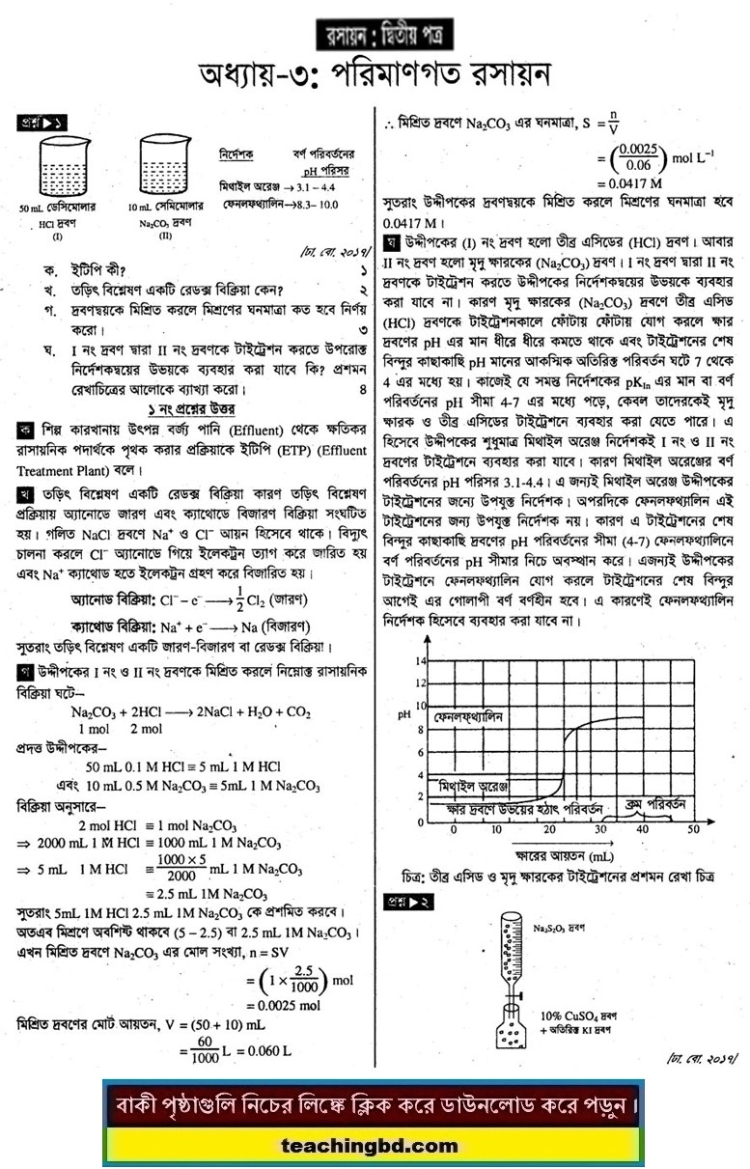HSC Chemistry 2nd Paper Note 3rd Chapter Quantitative Chemistry
HSC Chemistry 2nd Paper Note 3rd Chapter Quantitative Chemistry. Quantitative chemistry is a very important branch of chemistry because it enables chemists to calculate known quantities of materials. For example, how much product can be made from a known starting material or how much of a given component is present in a sample? Quantitative analysis is any method used for determining the amount of a chemical in a sample. The amount is always expressed as a number of appropriate units.
An acid-base titration is an example of quantitative analysis. In this module, you will learn about the core ideas or building blocks that are required for a deep understanding of quantitative chemistry. You will start to appreciate how relatively simple ideas develop and progress to more complex calculations as more knowledge is acquired. This line of progression is clearly seen in the thread of ideas, which may be used as a point of reference.
After working through this module you will be able to: understand the core ideas in quantitative chemistry; explain how the core ideas of quantitative chemistry develop and progress throughout secondary education; identify common misconceptions and know how these can be addressed; confidently and competently teach aspects of quantitative chemistry to secondary aged students; and access a range of activities and resources to support students in their learning of quantitative chemistry. Download your course development plan to keep a record of your learning and development.
HSC Chemistry 2nd Paper Note 3rd Chapter Quantitative Chemistry


Once the presence of certain substances in a sample is known, the study of their absolute or relative abundance can help in determining specific properties. Knowing the composition of a sample is very important, and several ways have been developed to make it possible, like the gravimetric and volumetric analysis. The gravimetric analysis yields more accurate data about the composition of a sample than volumetric analysis but also takes more time to perform in the laboratory. Volumetric analysis, on the other hand, doesn’t take that much time and can produce satisfactory results.
Volumetric analysis can be simply a titration based on a neutralization reaction but it can also be precipitation or a complex forming reaction as well as a titration based on a redox reaction. However, each method in quantitative analysis has a general specification, in neutralization reactions, for example, the reaction that occurs is between an acid and a base, which yields a grain of salt and water, hence the name neutralization. In the precipitation reactions, the standard solution is in the most cases silver nitrate which is used as a reagent to react with the ions present in the sample and to form a high insoluble precipitate.
Precipitation methods are often called simply as argentometry. In the two other methods, the situation is the same. Complex forming titration is a reaction that occurs between metal ions and a standard solution that is in the most cases EDTA (Ethylene Diamine Tetra Acetic acid). In the redox titration, that reaction is carried out between an oxidizing agent and a reduction agent.
teachingbd24.com is such a website where you would get all kinds of necessary information regarding educational notes, suggestions and questions’ patterns of school, college, and madrasahs. Particularly you will get here special notes of physics that will be immensely useful to both students and teachers. The builder of the website is Mr. Md. Shah Jamal Who has been serving for 33 years as an Asst. Professor of BAF Shaheen College Dhaka. He expects that this website will meet up all the needs of Bengali version learners /students. He has requested both concerned students and teachers to spread this website home and abroad.


